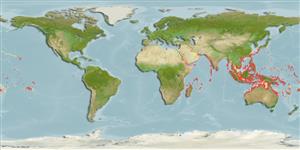Common names from other countries
Classification / Names / Names
Populärnamn | synonymer | Catalog of Fishes (gen., sp.) | ITIS | CoL | WoRMS
Environment: milieu / climate zone / depth range / distribution range
Ekologi
Revassocierade; djupintervall 0 - 40 m (Ref. 847). Tropical; 36°N - 29°S, 32°E - 137°W (Ref. 847)
Indo-Pacific.
Length at first maturity / Size / Vikt / Age
Maturity: Lm ? range ? - ? cm
Small colonies are encrusting, and larger ones develop vertical plates that anastomose to form an interlocking matrix. The sides and edges of the plates are quite smooth. Individual corallites are tiny, superficial and run in irregular rows (Ref. 269).
Common in shallow to intermediate depths and may form colonies several meters in diameter and in height (Ref. 269). Common in shallow to intermediate depths (Ref. 269) in most reef habitats (Ref. 98471). Growth varies with water conditions: large, thin plates in clear shelter waters; thick plates in exposed areas; and minimal ridges form in high turbidity. The bivalve Barbatia helblingi was reported to be bysally attached, wedged between the plates of this coral (Ref. 130769).
Life cycle and mating behavior
Könsmognad | Reproduktion | Lek | Ägg | Fecundity | Larver
Members of the class Anthozoa are either gonochoric or hermaphroditic. Mature gametes are shed into the coelenteron and spawned through the mouth. Life cycle: The zygote develops into a planktonic planula larva. Metamorphosis begins with early morphogenesis of tentacles, septa and pharynx before larval settlement on the aboral end.
Hodgson, G. 1998. (Ref. 269)
IUCN Red List Status (Ref. 130435)
CITES status (Ref. 108899)
Not Evaluated
Human uses
| FishSource |
Verktyg
Ytterligare information
Age/SizeTillväxtLength-weightLength-lengthMorfologiLarverAbundans
Internet-källor
Estimates based on models
Preferred temperature
(Ref.
115969): 24.7 - 29.1, mean 28 (based on 1136 cells).
Price category
Unknown.
